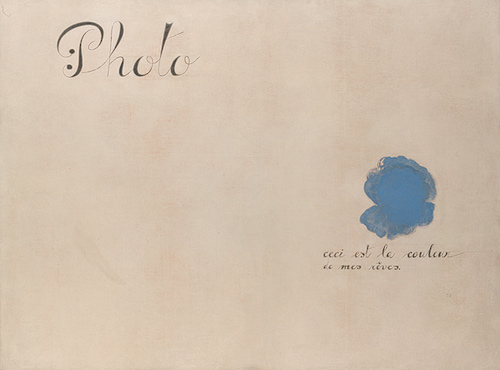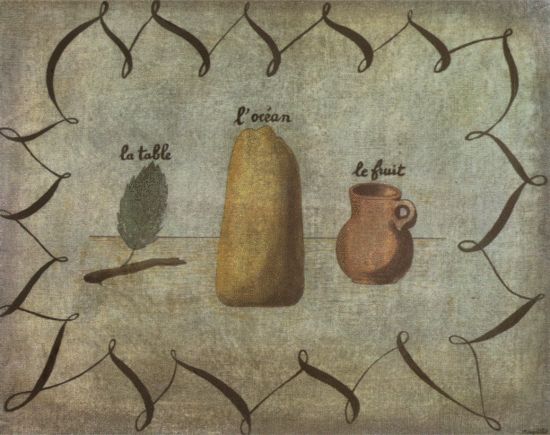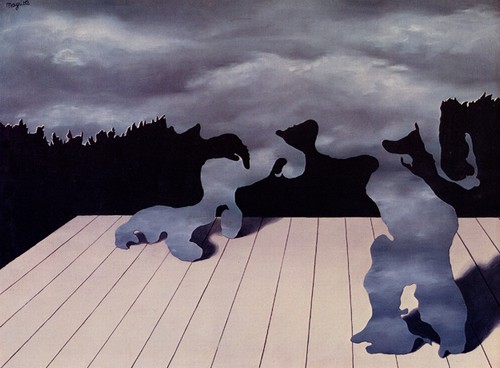Magritte: Precursors- Joan Miró
When Rene Magritte moved to le Perreaux-sur-Marne on the outskirts of Paris in 1927 one of the first surrealists he spent time with was Joan Miro. They met at art dealer Camille Goeman's in the rue Tourlaque in Montremont almost every Thursday for lunch. Goeman's left Brussels for Paris only one year before Magritte. Magritte surely spent some time in Miro's studio which was located nearby. According to Sylvester: "'Magritte paid visits to Miro's studio- which would explain both of the important new developments in his work which came about in the autumn of 1927." One of the developments Sylvester is referring to is Magritte's use of words and images which started in 1927 after his exposure to Miro's work.
The Catalan Surrealist Joan Miro 1893-1983 was born to the families of a goldsmith and watchmaker, the young Miró was drawn towards the arts community that was gathering in Montparnasse and in 1920 moved to Paris, France. There, under the influence of the poets and writers, he developed his unique style: organic forms and flattened picture planes drawn with a sharp line.
For Miro painting was poetry and poetry, painting. Is is thus not surprising to find caligraphic words intermingling on their own accord with the objects and images in many of Miró's paintings. It is rumored that he on occasion deprived himself of sleep for days to paint the subliminal organisms and hallucinatory animalitos crawling the walls of his studio. However, as with the other Surrealists, images from dreams and the use of Automatism as a means for free-flowing design were used as creative tools.

Photo: This Is the Color of My Dreams, 1925
Joan Miró (Spanish, 1893–1983)
Oil on canvas; 38 x 51 in. (96.5 x 129.5 cm)
The Pierre and Maria-Gaetana Matisse Collection, 2002 (2002.456.5)
Between 1924 and 1927, Miró created a group of paintings that are radically different from his earlier work. Known as peinture-poésie, these canvases, with broad and loosely brushed fields of color, are animated by just a few enigmatic signs. They are linked to his association, in the early 1920s, with the poets who later joined the Surrealist movement. The poets were the friends of his neighbor, the painter André Breton.
The present work, with its simple composition, is the most evocative of these works. Only three elements float on the white empty canvas: the word "Photo," the patch of blue, and the sentence "ceci est la couleur de mes rêves" (this is the color of my dreams). The black letters sit on faint, barely visible pencil lines that serve as guides for their sizes, as in a child's writing primer. When asked by the writer Georges Raillard about the meaning of the word "Photo," Miró said, "I started with the idea of a photo—I don't remember at all what photo it was. I neither did a collage nor a reproduction of it. I simply painted the word 'photo.'"
This painting had an illustrious chain of owners beginning with the poet Jacques Viot, who acted as the artist's first dealer in Paris.

Magritte: Table, Ocean, Fruit 1927
It's easy to see the connection of "Table, Ocean, Fruit," one of Magritte's early word and image paintings done in 1927, with Miro's 1925 "Photo: This Is the Color of My Dreams." What Magritte did was apply a twist- the words did not match the image of object.
Magritte also used forms to represent objects and people, perhaps also borrowed from Miro.

The Muscles of the Sky- 1927
Several of his paintings are clearly influenced by Miro.
%201927.jpg)
The Quandary of Painting (Les embarras de la peinture) 1927